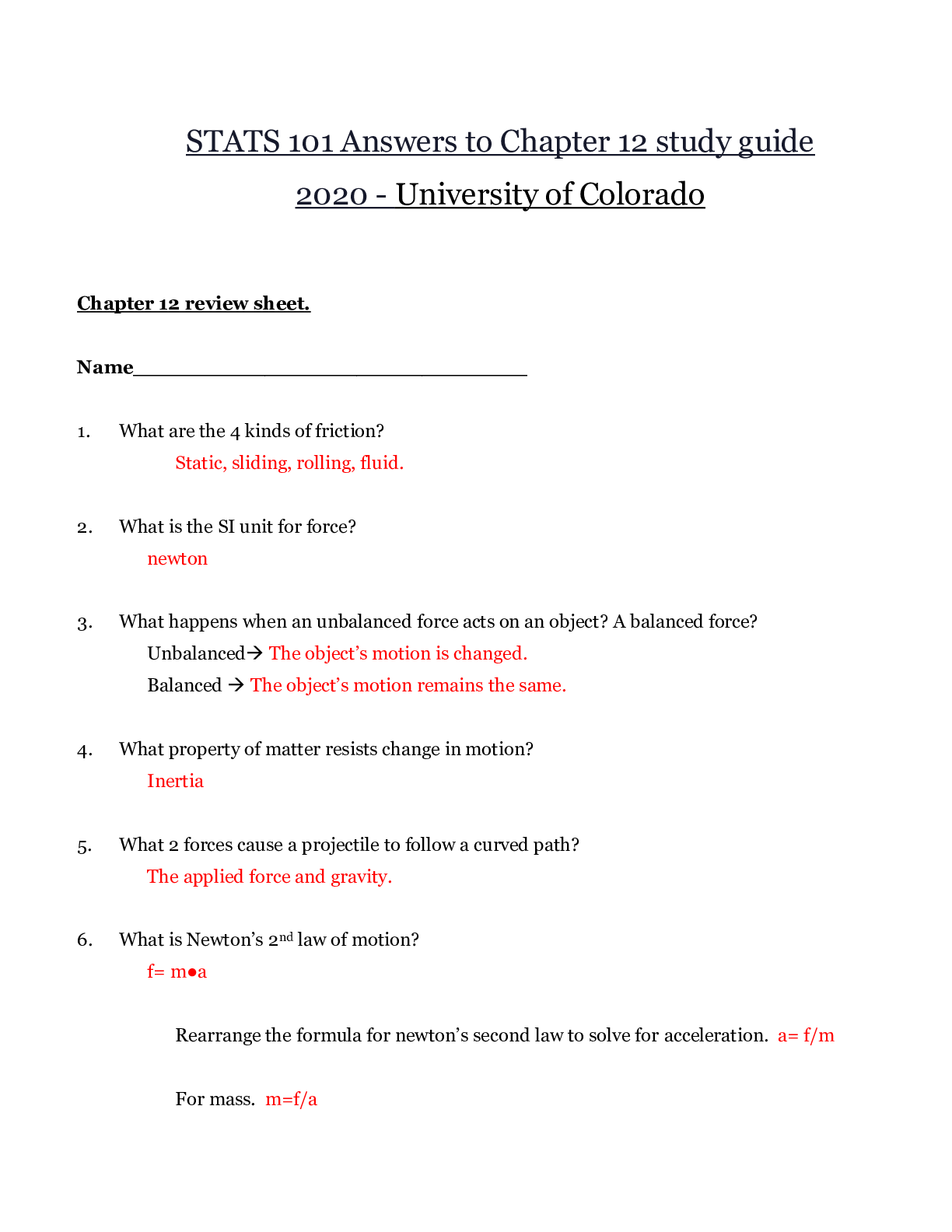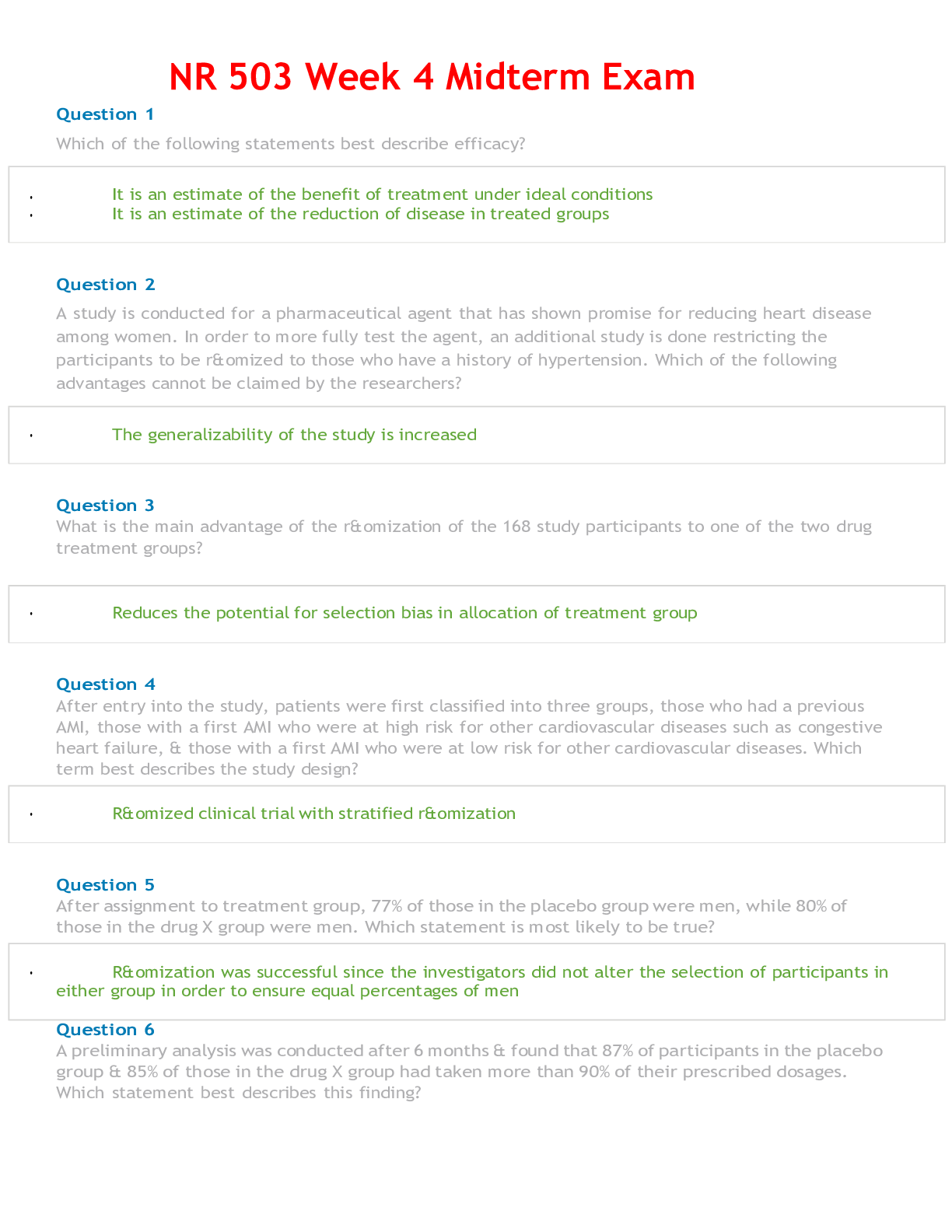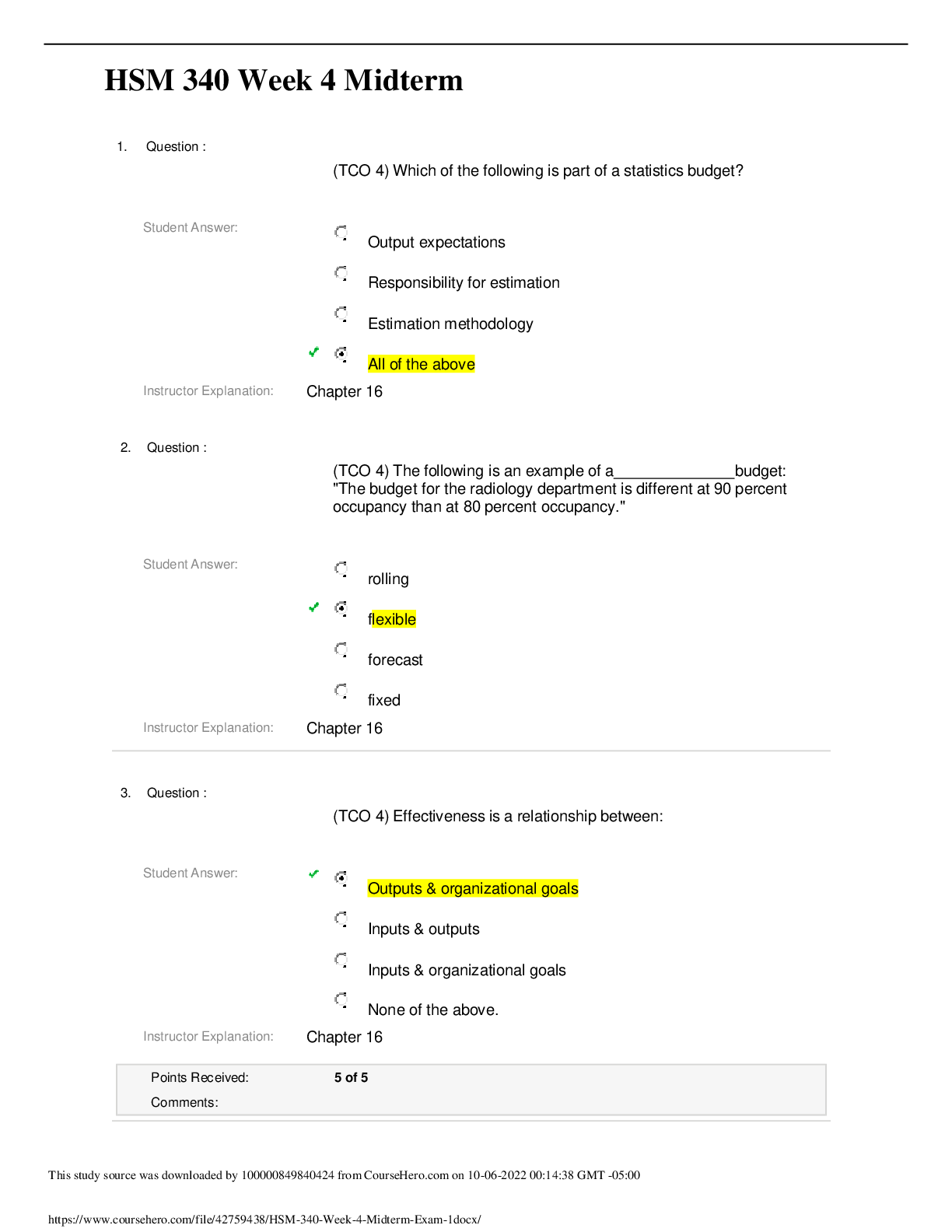Biology > EXAM > BIOL 2030 OSX_Microbiology_TestBank_Ch10 | 100% CORRECT solutions | University of Colorado (All)
BIOL 2030 OSX_Microbiology_TestBank_Ch10 | 100% CORRECT solutions | University of Colorado
Document Content and Description Below
Chapter 10: Biochemistry of the Genome * = Correct answer Multiple Choice 1. Gregor Mendel conducted his revolutionary work on patterns of inheritance using which organism? A. fruit flies B. pea... plants* C. roundworms D. snapdragons Difficulty: Easy ASM Standard: N/A 2. Which best describes true-breeding organisms? A. They are heterozygous at multiple loci. B. They have been produced through hybridization. C. They produce offspring identical to themselves when self-fertilized.* D. They produce offspring of the same species when self-fertilized. Difficulty: Easy ASM Standard: N/A TESTBANKSELLER.COM 3. In a monohybrid cross, the first generation of offspring is called which of the following? A. dihybrid generation B. first filial generation* C. parental generation D. second filial generation Difficulty: Easy ASM Standard: N/A 4. When Mendel published his work, most people believed which of the following about inheritance? A. A fully formed, miniature human was transmitted from the father. B. Blending of traits from both parents produces the traits of the offspring.* C. Genes are transmitted in DNA. D. Information from the mother provides the entire blueprint for the offspring. Difficulty: Easy ASM Standard: N/A 5. A DNA nucleotide contains which of the following? A. a deoxyribose sugar and a nitrogenous base B. a deoxyribose sugar, a phosphate, and a nitrogenous base* C. a ribose sugar and a nitrogenous base D. a ribose sugar, a phosphate, and a nitrogenous base Difficulty: Easy ASM Standard: N/A 6. A nucleoside contains which of the following components? A. a phosphate and a base B. a phosphate and a sugar C. a sugar and a base* D. a sugar, a phosphate, and a base Difficulty: Easy ASM Standard: N/A 7. Which of the following is a name for nitrogenous bases with a double-ring structure? A. nucleosides B. nucleotides C. purines* D. pyrimidines Difficulty: Easy ASM Standard: N/A TESTBANKSELLER.COM 8. Where in the DNA structure do DNA-binding proteins generally bind? A. in the center of the helix, between the bases B. in the major grooves C. in the minor grooves D. in the major and minor grooves* Difficulty: Easy ASM Standard: N/A 9. Which of the following is not an example of an organism’s phenotype? A. a behavioral response to certain conditions B. an organism’s observable characteristics C. the DNA sequence of a cellular genome* D. which enzymes are being synthesized Difficulty: Moderate ASM Standard: N/A 10. Who identified the nucleotide bases of DNA and RNA? A. Richard Altmann B. Albrecht Kossel* C. Gregor Mendel D. Friedrich Miescher Difficulty: Moderate ASM Standard: N/A 11. Mendel published his work in which of the following books? A. Experiments in Plant Hybridization* B. On the Origin of Species C. The Double Helix D. The Physical Basis of Heredity Difficulty: Moderate ASM Standard: N/A 12. Whose work provided the first experimental evidence for the Chromosomal Theory of Inheritance? A. Theodor Boveri’s work with sea urchins B. Barbara McClintock’s work with maize C. Gregor Mendel’s work with pea plants D. Thomas Hunt Morgan’s work with Drosophila* Difficulty: Moderate ASM Standard: N/A TESTBANKSELLER.COM 13. Which alga provided an important model to demonstrate the location of genetic information in the nucleus? A. Acetabularia* B. Chlamydomonas C. Ulva D. Volvox Difficulty: Moderate ASM Standard: N/A 14. The one gene–one enzyme hypothesis that developed into the one gene–one polypeptide hypothesis was proposed by which of the following? A. George Beadle, Edward Tatum, and colleagues* B. Gregor Mendel C. Matthew Meselson and Franklin Stahl D. Thomas Hunt Morgan Difficulty: Easy ASM Standard: N/A 15. Evidence that DNA was the genetic material rather than protein was provided by which of the following? A. Oswald Avery, Colin MacLeod, and Maclyn McCarty B. George Beadle, Edward Tatum, and colleagues C. Alfred Hershey and Martha Chase* D. Matthew Meselson and Franklin Stahl Difficulty: Moderate ASM Standard: N/A 16. Who first demonstrated horizontal transmission of genetic information? A. Oswald Avery B. Frederick Griffith* C. Barbara McClintock D. Thomas Hunt Morgan Difficulty: Moderate ASM Standard: N/A 17. Which of the following correctly describes the number and type of bond(s) that stabilize an adenine–thymine base pair? A. one hydrogen bond B. one phosphodiester bond C. two hydrogen bonds* D. three hydrogen bonds Difficulty: Moderate ASM Standard: N/A TESTBANKSELLER.COM 18. Which of the following describes the relationship in which the amount of adenine equals the amount of thymine, and the amount of guanine equals the amount of cytosine in double- stranded DNA? A. Chargaff’s rules* B. Griffith’s rules C. Mendel’s laws D. Pauling’s principles Difficulty: Moderate ASM Standard: N/A 19. Which researchers published the first description of DNA as a double helix? A. Francis Crick and Linus Pauling B. Rosalind Franklin and Linus Pauling C. Rosalind Franklin and Maurice Wilkins D. James Watson and Francis Crick* Difficulty: Moderate ASM Standard: N/A 20. Which researcher produced X-ray diffraction images of DNA that were critical to determining its structure but did not receive a Nobel prize with colleagues because it is not awarded posthumously? A. Francis Crick B. Rosalind Franklin* C. James Watson D. Maurice Wilkins Difficulty: Moderate ASM Standard: N/A 21. One strand of DNA runs from 5′ to 3′ and the opposing strand runs 3′ to 5′, meaning that the strands are oriented in which way? A. antiparallel* B. conservative C. helical D. semiconservative Difficulty: Moderate ASM Standard: N/A TESTBANKSELLER.COM 22. The rejoining of two previously separated strands of DNA is called which of the following? A. denaturation B. hydrogenation C. reannealing* D. semiconservative replication Difficulty: Moderate ASM Standard: N/A 23. DNA strands are often denatured in the laboratory using which method? A. adding restriction enzymes B. freezing the sample C. raising the temperature* D. using a cold calcium chloride solution Difficulty: Moderate ASM Standard: N/A 24. Transmission of genetic information from parent to offspring is called which of the following? A. horizontal gene transfer B. phage transfer C. transposition D. vertical gene transfer* Difficulty: Moderate ASM Standard: N/A 25. Which of the following is not a difference between DNA and RNA? A. DNA is used for shorter-term functions than RNA.* B. DNA is usually double stranded and RNA is usually single stranded. C. RNA contains uracil and DNA contains thymine. D. RNA is usually less stable than DNA. Difficulty: Moderate ASM Standard: N/A 26. Which process produces an RNA copy of a DNA molecule? A. replication B. transcription* C. transformation D. translation Difficulty: Moderate ASM Standard: N/A TESTBANKSELLER.COM 27. In which cellular location in a eukaryote do rRNA synthesis and ribosome assembly occur? A. at ribosomes attached to the rough endoplasmic reticulum B. in the cytoplasm C. in the nucleolus* D. in the pores of the nuclear envelope Difficulty: Moderate ASM Standard: N/A 28. Which of the following is located on the 5′ end of a DNA strand? A. a phosphate group* B. the amino group of a nitrogenous base C. the hydroxyl group of a deoxyribose sugar D. the hydroxyl group of a ribose sugar Difficulty: Difficult ASM Standard: N/A 29. What happens to pyrophosphate released during phosphodiester bond formation? A. It forms hydrogen bonds with nitrogenous bases. B. It forms phosphodiester bonds with RNA. C. It is hydrolyzed to release energy.* D. It is immediately joined to another nucleotide. Difficulty: Difficult ASM Standard: N/A 30. Who suggested that the DNA molecule may have three strands? A. Francis Crick B. Rosalind Franklin C. Linus Pauling* D. James Watson Difficulty: Difficult ASM Standard: N/A 31. Streptococcus mutans only expresses the genes for slime-layer production when which of the following occurs? A. constitutive genes are activated B. sucrose is present* C. the environment is strongly acidic D. the temperature is sufficiently high Difficulty: Difficult ASM Standard: 17, 20, 22 TESTBANKSELLER.COM 32. Which enzymes help prevent supercoiling? A. histones B. polymerases C. primases D. topoisomerases* Difficulty: Difficult ASM Standard: N/A 33. Which describes a stable change in gene expression without changing the base sequence? A. epigenetics* B. mutation C. replication D. transformation Difficulty: Difficult ASM Standard: N/A 34. Which term best describes the DNA in chloroplasts? A. extrachromosomal* B. noncoding C. single stranded D. viral Difficulty: Difficult ASM Standard: N/A 35. Which best describes the mitochondrial DNA chromosome? A. It is circular.* B. It is identical to chloroplast DNA. C. It is viral. D. It lacks thymine. Difficulty: Difficult ASM Standard: 34 True/False 36. DNA is important contributor to the physical structure of components throughout the cell. Answer: False Difficulty: Easy ASM Standard: N/A 37. Extrachromosomal DNA can be viral. Answer: True Difficulty: Easy ASM Standard: N/A TESTBANKSELLER.COM 38. The presence of double-stranded RNA suggests a viral infection. Answer: True Difficulty: Moderate ASM Standard: N/A 39. An organism’s genotype describes its appearance and genetic makeup. Answer: False Difficulty: Moderate ASM Standard: N/A 40. Noncoding DNA appears to have very few functions and is known as “junk DNA.” Answer: False Difficulty: Moderate ASM Standard: N/A 41. Prokaryotes are generally haploid. Answer: True Difficulty: Moderate ASM Standard: N/A 42. Ribosomal RNA is shorter than messenger RNA and transfer RNA. Answer: False Difficulty: Difficult ASM Standard: N/A 43. The peptidyl transferase enzymatic activity of ribosomes is due to rRNA. Answer: True Difficulty: Difficult ASM Standard: N/A Matching 44. Match each scientist or scientists with their work. A. George Beadle, Edward Tatum, i. described a double-helix model of DNA structure and colleagues B. Alfred Hershey and Martha TCEhaSseTBiAi.NdKemSoEnLstLraEteRd.thCaOt MX-ray exposure causes mutations C. Hermann Mueller iii. used bacteriophages to show that DNA was the genetic material D. James Watson and Francis Crick iv. developed the “one gene–one enzyme” hypothesis Answers: A. iv., B. iii., C. ii., D. i. Difficulty: Easy ASM Standard: N/A 45. Match each type of RNA with the best description. A. messenger RNA i. short, unstable, single-stranded RNA that encodes genetic information B. ribosomal RNA ii. short, stable RNA with extensive intramolecular base pairing C. transfer RNA iii. relatively long, stable RNA involved in catalyzing bond formation and stabilizing the structures involved in translation Answers: A. i., B. iii., C. ii. Difficulty: Moderate ASM Standard: N/A 46. Match the scientist with his work. A. Frederick Griffith i. worked with Acetabularia to show that the nucleus contains the genetic material B. Joachim Hämmerling ii. found evidence for the Chromosomal Theory of inheritance and is known for work with fruit flies C. Gregor Mendel iii. examined inheritance patterns and showed that inheritance does not result from the blending of traits D. Thomas Hunt Morgan iv. demonstrated transformation in Streptococcus pneumoniae Answers: A. iv., B. i., C. iii., D. ii. Difficulty: Moderate ASM Standard: N/A 47. Match each molecule with its description. A. chromatin i. an enzyme that helps prevent overwinding of the DNA during DNA replication B. histone ii. an RNA enzyme that catalyzes bond formation during translation C. peptidyl transferase iii. protein around which DNA is wrapped D. topoisomerase iv. DNA and the proteins around which it is arranged Answers: A. iv., B. iii., C. ii., D. i. Difficulty: Moderate ASM Standard: N/A TESTBANKSELLER.COM 48. Match each base with the best description. A. adenine i. a purine that binds with cytosine B. cytosine ii. a purine that binds with thymine C. guanine iii. a pyrimidine that binds with adenine D. thymine iv. a pyrimidine that binds with guanine Answers: A. ii., B. iv., C. i., D. iii. Difficulty: Easy ASM Standard: N/A 49. Match each scientist with his or her work. A. Richard Altmann i. isolated chemicals from pus that are now known to be DNA and RNA B. Erwin Chargaff ii. developed the rules that A=T and C=G in double- stranded DNA C. Rosalind Franklin iii. first used the term “nucleic acid” for DNA and RNA D. Barbara McClintock iv. used X-ray diffraction to produce images that were critical to determining the structure of DNA E. Friedrich Miescher v. identified transposons Answers: A. iii., B. ii., C. iv, D. v., E. i. Difficulty: Difficult ASM Standard: N/A Fill in the Blank 50. The type of chemical bonds that hold together the two strands of a DNA double helix are called bonds. Answer: hydrogen Difficulty: Easy ASM Standard: N/A 51. Thomas Hunt Morgan worked with the model organism . Answer: Drosophila melanogaster (fruit flies) Difficulty: Easy ASM Standard: N/A 52. are a type of topoisomerase in prokaryotes. Answer: Gyrases Difficulty: Easy ASM Standard: N/A 53. is a purine that formTsEtShTreBe AhyNdKroSgEenLbLoEnRds.wCiOthMits complementary pyrimidine. Answer: Guanine Difficulty: Moderate ASM Standard: N/A 54. The DNA nucleotides in a single strand of DNA are connected by a type of covalent bond called a . Answer: phosphodiester bond Difficulty: Moderate ASM Standard: N/A 55. are also known as jumping genes. Answer: Transposons Difficulty: Moderate ASM Standard: N/A 56. The alga that was useful in determining that the genetic material is located in the nucleus is . Answer: Acetabularia Difficulty: Moderate ASM Standard: N/A 57. Frederick Griffith showed that horizontal gene transfer can occur through a process he called . Answer: transformation Difficulty: Moderate ASM Standard: N/A 58. A molecule with a sugar and base but no phosphate is called a . Answer: nucleoside Difficulty: Moderate ASM Standard: N/A 59. Ribose has five carbons, so it is referred to as a sugar. Answer: pentose Difficulty: Moderate ASM Standard: 20 60. Hershey and Chase showed that DNA carries genetic information using the bacteriophage. Answer: T2 Difficulty: Difficult ASM Standard: 11, 20, 22 Short Answer TESTBANKSELLER.COM 61. Why is it important that Mendel used true-breeding plants? Sample Answer: True-breeding plants are homozygous, meaning that the two alleles are the same for each trait. This makes crosses easier to interpret because the researcher knows what alleles are carried by all gametes for a trait of interest. Difficulty: Moderate ASM Standard: N/A 62. What are proteases, such as the proteases used by Oswald Avery, Colin MacLeod, and Maclyn McCarty? Sample Answer: Proteases are enzymes that digest proteins, breaking them down so that they can no longer function. Difficulty: Easy ASM Standard: N/A 63. What are phages? Why are they useful for genetic studies? Sample Answer: Phages, or bacteriophages, are viruses that infect bacteria. They are useful for genetic studies because they have a simple structure and are easy to manipulate. They infect bacteria, which are easy to grow in the laboratory. Difficulty: Easy ASM Standard: N/A 64. What are transposons? Sample Answer: Transposons are DNA segments that can move from one place to another within the genome. Difficulty: Easy ASM Standard: N/A 65. What is the difference between the rough and smooth strains of Streptococcus pneumoniae and what is the significance of this difference in the virulence of S. pneumoniae? Sample Answer: The rough strain of S. pneumoniae produces colonies that have a rough appearance because they lack capsules. The smooth strain produces colonies that appear smooth because they have capsules. The capsule is important in allowing S. pneumoniae to cause disease, because it helps protect the bacteria from phagocytosis. Difficulty: Moderate ASM Standard: N/A TESTBANKSELLER.COM 66. The “one gene–one enzyme” hypothesis was later modified. Give an example of something encoded by a gene that is not an enzyme. Sample Answer: Answers may vary. Some genes encode polypeptides that form structural proteins in the cell. Additionally, some genes encode rRNA molecules or tRNA molecules. Difficulty: Moderate ASM Standard: N/A 67. If you radioactively labeled the phosphorus in a cell, would RNA become radioactive? Sample Answer: Yes. Phosphorus is found in RNA, so the RNA would become radioactive. Difficulty: Moderate ASM Standard: N/A 68. DNA replication is semiconservative. What does this mean? Sample Answer: When DNA is replicated, a DNA molecule splits into two single parental strands. Each parental strand serves as a template for the synthesis of a complementary daughter strand, resulting in two double-stranded DNA molecules. Therefore, one of the two strands in each new DNA molecule is conserved from the parental DNA molecule, whereas the other strand is newly synthesized. Difficulty: Moderate ASM Standard: N/A 69. Explain complementary base pairing in DNA and RNA. Sample Answer: The complementary base pairing rules are 1) adenine always forms hydrogen bonds with thymine and 2) cytosine always forms hydrogen bonds with guanine in DNA. In RNA, there is no thymine, so adenine instead bonds with uracil. Difficulty: Moderate ASM Standard: N/A 70. Prokaryotic cells are generally haploid. How does this affect their utility as model organisms to study inheritance patterns, such as those studied by Mendel? Sample Answer: Because they are haploid, they do not have alleles that are not expressed, such as the recessive alleles that are hidden by dominant alleles in eukaryotic organisms. This can make them very useful for certain types of genetic studies but means that they would not be useful for doing crosses like those that Mendel did using pea plants. Difficulty: Moderate ASM Standard: N/A 71. Compare the amount of noncoTdEinSgTDBNAANKinSpEroLkLarEyoRt.esCaOndMeukaryotes. Sample Answer: Eukaryotes have much more noncoding DNA than prokaryotes. Although the amounts vary considerably by species, the average amount of noncoding DNA is 12% for prokaryotes and 98% for eukaryotes. Difficulty: Moderate ASM Standard: N/A 72. How would an antibiotic that targeted a gyrase kill a bacterial cell? Sample Answer: Gyrases prevent overwinding during DNA replication. If they are inactivated, the DNA can become damaged by becoming packed too tightly, DNA replication stops, and cells will die. Difficulty: Moderate ASM Standard: 14 73. Think carefully about the structure of DNA, including that in viruses. Does the amount of adenine always equal the amount of thymine in a DNA sample? Explain. Sample Answer: The amount of adenine always equals the amount of thymine in double- stranded DNA. However, even though DNA is usually double stranded, it is not always double stranded. If your sample happened to contain single stranded DNA (e.g., if you had denatured it with heat and then taken out some material for further analysis), then the amounts of adenine and thymine may not be equal. Viruses have varied genomes. Some have single-stranded DNA instead of double-stranded DNA in their genome. In these cases, the amount of adenine may not be equal to the amount of thymine. Difficulty: Difficult ASM Standard: N/A 74. How are epigenetic changes able to influence phenotypes without changing the sequence of nitrogenous bases in DNA? Sample Answer: Epigenetic changes affect gene expression. For example, methylation of nucleotides can affect the expression of those nucleotides by affecting DNA packaging. By changing the expression of genes, it is possible to change phenotypes without changing the sequence of bases. Difficulty: Difficult ASM Standard: N/A Brief Essay Essay Question Rubric RATING Failing Below Average Competent Advanced Criteria for evaluation Answer does not provide an argument. Answer contains inaccuracies. Writing is poor and contains numerous grammatical mistakes and misspellings. Answer fails to provide examples to support an argument. Writing is poor L and grammatical errors are common. Answer is somewhat incoherent. Answer provides an argument with one or two examples that support it. Writing is acceptable for the college level but may contain one or two grammatical mistakes or misspellings. Answer clearly provides an argument with two or more excellent examples that support it; student makes the argument clearly and eloquently. Answer is well organized and free of grammatical errors and misspellings. POINT VALUE 0 1 2 3 Assume rating/grading scale for the question ranges from 0 to 3 points. 75. What are some reasons that fruit flies, pea plants, and microbes such as Acetabularia are good model systems for studying genetics? Answer: Student answers may vary. Some reasons, for example, are that these organisms are used to study genetics because they have relatively short generation times, are easy to raise in the laboratory, and are easy to breed in a controlled way so parent crosses are known. Difficulty: Moderate ASM Standard: 25 76. Compare and contrast the pros and cons of using bacteria versus fruit flies for genetic studies. Answer: Student answers will vary but should include the following. Many species of bacteria are easy to raise in the laboratory, as are fruit flies, and generation times are short. Therefore, both types of organisms are easy to work with in the laboratory. However, they differ in that bacteria are prokaryotes and fruit flies are eukaryotes, meaning they have different numbers of chromosomes and cellular machinery relating to DNA. In addition, bacteria are haploid and fruit flies are diploid. Because bacteria are haploid, they do not have alleles that don’t get expressed, such as the recessive alleles that are hidden by dominant alleles in eukaryotic organisms. Therefore, genetic experiments, such as those performed by Mendel, cannot be performed with bacteria. In addition, bacteria reproduce using binary fission, whereas fruit flies use sexual reproduction. Because binary fission is a form of cloning, the offspring of bacteria are usually identical to the parent. This is not true with sexual reproduction, where offspring contain the DNA of both parents Difficulty: Moderate ASM Standard: 25 77. How would the results of Avery, MacLeod, and McCarty’s experiment have differed if RNA had been the molecule of inheritance instead of DNA? Answer: Student answers will vary but should include the following. In this experiment, Avery, MacLeod, and McCarty inactivated different cellular molecules to see which one was responsible for bacterial transformation, thereby identifying the molecule of heredity. They found that using deoxyribonucleases prevented transformation from occurring because these enzymes digested DNA. If RNA had actually been the critical genetic material for transformation, then transformTaEtiSonTBwAouNldKhSaEvLe LocEcuRr.reCdOafMter the use of deoxyribonucleases as long as the RNA was intact. Instead, ribonucleases would degrade the RNA, thus preventing transformation from occurring. Difficulty: Difficult ASM Standard: N/A 78. Explain how some disease-causing microbes may cause epigenetic changes that can help protect them from the host’s immune system. Give at least one specific example. Answer: Student answers will vary but should include components of the following. Some bacteria, such as Helicobacter pylori and Shigella flexneri, can remodel the chromatin in the host cells. If the chromatin is made more tightly packed, then RNA polymerase cannot access the DNA to express the genes. This turns off the tightly packed genes and can affect the immune response. Difficulty: Difficult ASM Standard: 23 This file is copyright 2017, Rice University. All rights reserved. [Show More]
Last updated: 1 year ago
Preview 1 out of 16 pages

Buy this document to get the full access instantly
Instant Download Access after purchase
Add to cartInstant download
We Accept:

Reviews( 0 )
$13.50
Document information
Connected school, study & course
About the document
Uploaded On
Dec 13, 2021
Number of pages
16
Written in
Additional information
This document has been written for:
Uploaded
Dec 13, 2021
Downloads
0
Views
27






.png)










.png)




.png)



